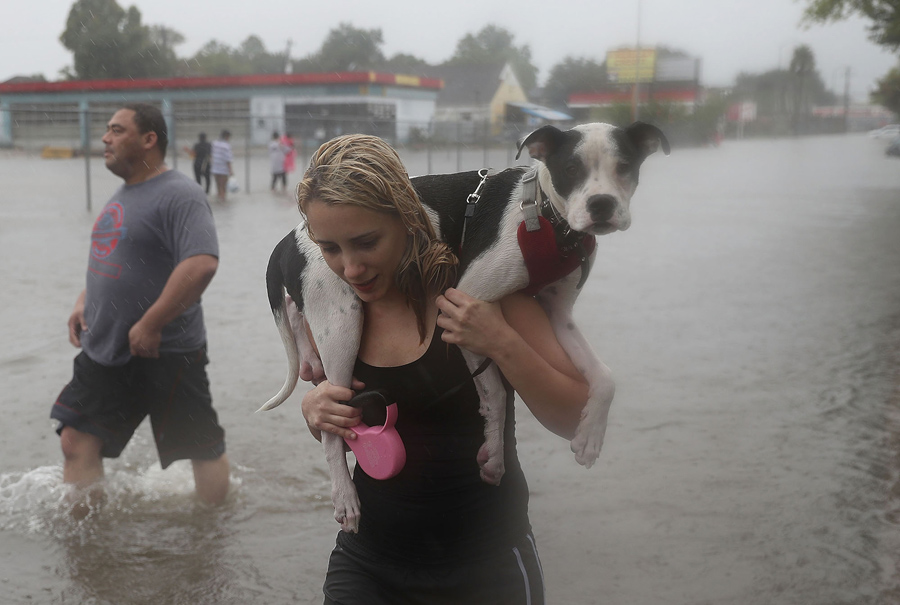The director of the National Weather Service is warning that the catastrophic flooding that’s overwhelming Houston and other parts of Texas will worsen in the coming days and then be slow to recede once Harvey finally moves on.
Director Louis Uccellini said during a news conference Monday that up to 20 inches of rain could fall in the coming days, on top of the more than 30 inches some places have already seen.
He says some of the heaviest rainfall today, at a pace of 6 inches an hour, will fall east of Houston in places such as Beaumont and Lake Charles, Louisiana.
He adds that while Houston is experiencing a break from the rain Monday morning, heavy rainfall is forecast to return later in the day into Tuesday.
___
Houston police chief, Art Acevedo, is concerned about the prospect of more flooding, but is “keeping fingers crossed” that the rain will subside.
In an interview Monday on MSNBC’s “Morning Joe,” Chief Art Acevedo says drainage is a concern.
Acevedo said “not sure where the water is going because it’s just so much that we can’t really absorb more in the ground at this point. … We have way too much water and not enough places for it to drain.”
He says officers have voiced frustration that they don’t have enough high-water vehicles to quickly help everyone who is stranded.
He also warned any criminals who might try to take advantage of the disaster that his force has already arrested half a dozen people for looting.
__
The Federal Emergency Management Agency (FEMA) is asking for volunteers to help Texas recover from Harvey.
William “Brock” Long, FEMA administrator, told a news conference in Washington Monday that “we need citizens to be involved,” because the storm and resulting flooding is greater than the government can handle.
[Pundita note: For crying out loud, hasn't FEMA been following the news? Hundreds if not thousands of volunteers have already been helping -- risking their boats and their safety all day yesterday and last night (and probably on Saturday night as well) to rescue stranded people. Many of those volunteers came to Houston from as far away as Austin and even further away to help, and fanned out to assist in other flooded areas in Texas as well, such as the city of Katy.
Okay, I understand why FEMA would have made an 'official' request for volunteers but Mr Long might have taken a few seconds to thank the people who are already volunteering and under tough conditions.]
Long urges individuals and organizations to check the website www.nvoad.org or call 1-800-621-FEMA to find out how to help. He’s asking for financial donations and for people “to figure out how to get involved as we help Texas find a new normal.”
A National Weather Service official says the peak flooding from the Houston-area storm is expected to max out Wednesday and Thursday, but said the floods will be slow to recede and that catastrophic flooding will persist.
___
Harvey continues to head back toward the Gulf of Mexico at a slow pace.
The National Hurricane Center says in its 4 a.m. CDT update that the tropical storm that made landfall late Friday as a Category 4 hurricane, dropping heavy rain in the Houston area, still has sustained winds of up to 40 mph (65 kph) and is centered 20 miles (30 kilometers) east of Victoria, Texas, about 120 miles (193 kilometers) southwest of Houston. It continues to creep to the southeast at 3 mph (4.8 kph).
That means it remains virtually stalled near the coast and continues to drop heavy rain on the Houston and Galveston areas. In the past 48 hours, numerous spots in the region have measured more than 25 inches (64 centimeters) of rain.
The hurricane center says Harvey’s center was expected to drift off the middle Texas coast on Monday and meander offshore through Tuesday before beginning “a slow northeastward motion.” The center says those in the upper Texas coast and in southwestern Louisiana should continue to monitor Harvey’s progress.
___
Officials released more water from Houston-area reservoirs overwhelmed by Harvey early Monday in a move aimed at protecting the city’s downtown from devastating floods, but that could still endanger thousands of homes, even as the city braced for more rain.
Residents living near the Addicks and Barker reservoirs — that were designed to prevent flooding in downtown Houston — were warned Sunday that a controlled release from both reservoirs would cause additional street flooding that could spill into homes. Rising water levels and continuing rain was putting pressure on the dams that could cause a failure without the release.
Harris and Fort Bend county officials advised residents to pack their cars Sunday night and wait for daylight Monday to leave.
“The idea is to prepare … pack up what you need and put it in your vehicle and when the sun comes up, get out,” said Jeff Lindner, a meteorologist for the Harris County Flood Control District. “And you don’t have to go far, you just need to get out of this area.”
The Army Corps of Engineers started the reservoir releases before 2 a.m. Monday — ahead of schedule — because water levels were increasing dramatically at a rate of more than six inches (15 centimeters) per hour, a Corps spokesman Jay Townsend said. The timetable was moved up to prevent more homes from being flooded, Townsend said.
Meanwhile, officials in Fort Bend County, Houston’s southwestern suburbs, late Sunday issued widespread mandatory evacuation orders along the Brazos River levee districts.
County officials were preparing for the river to reach major flood stages late Sunday. County Judge Robert Herbert said at a news conference that National Weather Service officials were predicting that the water could rise to 59 feet (18 meters), three feet (90 centimeters) above 2016 records and what Herbert called an “800-year flood level.” Herbert said that amount of water would top the levees and carries a threat of levee failure.
In a rescue effort that recalled the aftermath of Hurricane Katrina, helicopters landed near flooded freeways, airboats buzzed across submerged neighborhoods and high-water vehicles plowed through water-logged intersections. Some people managed with kayaks or canoes or swam.
[Pundita note: I hope the swimmers get antibiotics in them ASAP, given the state of those waters]
olunteers joined emergency teams in pulling people from their homes or from the water. The flooding was so widespread that authorities had trouble pinpointing the worst areas. They urged people to get on top of their houses to avoid becoming trapped in attics and to wave sheets or towels to draw attention to their location.
Judging from federal disaster declarations, the storm has so far affected about a quarter of the Texas population, or 6.8 million people in 18 counties. It was blamed in at least two deaths.
As the water rose, the National Weather Service issued another ominous forecast: Before the storm that arrived Friday as a Category 4 hurricane is gone, some parts of Houston and its suburbs could get as much as 50 inches (1.3 meters) of rain. That would be the highest amount ever recorded in Texas.
Some areas have already received about half that amount. Since Thursday, South Houston recorded nearly 25 inches (63 centimeters), and the suburbs of Santa Fe and Dayton got 27 inches (69 centimeters).
“The breadth and intensity of this rainfall is beyond anything experienced before,” the National Weather Service said in a statement.
Average rainfall totals will end up around 40 inches (1 meter) for Houston, weather service meteorologist Patrick Burke said.
The director of the Federal Emergency Management Agency, Brock Long, predicted that the aftermath of the storm would require FEMA’s involvement for years.
“This disaster’s going to be a landmark event,” Long said.
Rescuers had to give top priority to life-and-death situations, leaving many affected families to fend for themselves. And several hospitals in the Houston area were evacuated due to the rising waters.
It was not clear how many people were plucked from the floodwaters. Up to 1,200 people had to be rescued in Galveston County alone, said Mark Henry, the county judge, the county’s top administrative post.
Houston’s George R. Brown Convention Center was quickly opened as a shelter. It was also used as a shelter for Katrina refugees in 2005.
Gillis Leho arrived there soaking wet. She said she awoke Sunday to find her downstairs flooded. She tried to move some belongings upstairs, then grabbed her grandchildren.
“When they told us the current was getting high, we had to bust a window to get out,” Leho said.
Some people used inflatable beach toys, rubber rafts and even air mattresses to get through the water to safety. Others waded while carrying trash bags stuffed with their belongings and small animals in picnic coolers.
Houston Mayor Sylvester Turner said authorities had received more than 2,000 calls for help, with more coming in. He urged drivers to stay off roads to avoid adding to the number of those stranded.
“I don’t need to tell anyone this is a very, very serious and unprecedented storm,” Turner told a news conference. “We have several hundred structural flooding reports. We expect that number to rise pretty dramatically.”
The deteriorating situation was bound to provoke questions about the conflicting advice given by the governor and Houston leaders before the hurricane. Gov. Greg Abbott urged people to flee from Harvey’s path, but the Houston mayor issued no evacuation orders and told everyone to stay home.
The governor refused to point fingers on Sunday.
[...]
[List of reporters from the same AP website report titled, Rescuers pluck hundreds from rising floodwaters in Houston: Lead reporter "MICHAEL GRACZYK; Associated Press writers Carla K. Johnson in Chicago; Juan Lozano, Josh Replogle and Robert Ray in Houston; Peter Banda in Dickinson, Texas; and Jamie Stengle and Claudia Lauer in Dallas contributed to this report."]
[END AP REPORT]
********





